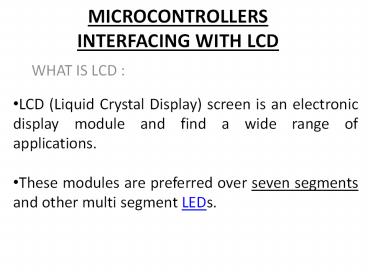microcontroller interfacing with lcd PowerPoint PPT Presentation
Title: microcontroller interfacing with lcd
1
MICROCONTROLLERS INTERFACING WITH LCD
- WHAT IS LCD
- LCD (Liquid Crystal Display) screen is an
electronic display module and find a wide range
of applications. - These modules are preferred over seven segments
and other multi segment LEDs.
2
- The reasons being
- LCDs are economical
- Easily programmable
- Have no limitation of displaying special even
custom characters (unlike in seven segments),
animations and so on.
3
LCD PIN DIAGRAM
4
LCD PIN DESCRIPTION
- The following are the main three steps in
displaying any data in the LCD display - Initializing LCD by sequence of instructions
- Executing commands depending on our settings in
the LCD - Writing data into the DRAM locations of LCD in
the Standard Character Pattern of LCD
5
Key specifications of LCD display Important
factors to consider when evaluating an LCD
monitor 1. Resolution The horizontal and
vertical size measured by number of pixels (e.g.,
1024x768). 2. Dot pitch The distance between
the centers of two adjacent pixels. Smaller dot
pitch indicate sharper image. 3. Viewable
size The diagonal size of the LCD display panel
4. Response time The minimum time LCD takes to
change a pixel's color or brightness.
6
5. Refresh rate The rate at which the data is
loaded in the monitor measured with the unit of
number of times per second. Higher the
refresh rate lesser is the flickering. 6. Matrix
type Active TFT or Passive.7. Viewing angle
The angle from which the user can view the image
on the display clearly. 8. Color support The
types and number of colors supported by the LCD
(known as color gamut).9. Brightness The amount
of light emitted from the display (known as
luminance).
7
10. Contrast ratio The ratio of the intensity of
the brightest bright to the darkest dark.11.
Aspect ratio The ratio of the width to the
height (for example, 43, 54, 169 or 1610).
Gamma correction It is the name of a nonlinear
operation used to code and decode luminance or
tristimulus values in video or still image systems
8
- Advantages of LCDs
- Consumes less power and generates less heat.
- Saves lot of space compared picture tubes due
to LCD's flatness. - Due to less weight and flatness LCDs are
highly portable. - No flicker and fewer screens glare in LCDs to
reduce eyestrain.
9
- Drawbacks
- The disadvantages of LCD displays are
- LCDs cannot form multiple resolution images.
- The contrast ratio for LCD images is lesser than
CRT and plasma displays. - Due to their longer response time, LCDs show
ghost images and mixing when images change
rapidly. - The narrow viewing angle of an LCD weakens the
image quality in wider viewing angles.

